These new technologies make eye feast - "International Symposium on New Progress in Ophthalmology" was held in Shenyang
Ophthalmologists from all over the world recently gathered in Shenyang, with 20 doctors one by one showing their skills. The most advanced ophthalmology technology in the world impressed ophthalmologists from all over the country.
"The International Symposium on New Progress in Ophthalmology and the 21st Symposium on Eye Microsurgery of He Vision Group" was held in He University from September 17 to 18, 2016.
More than 10 experts from all over the world, including Douglas Fredrick, Vice Chairman of the Medical Center of Lucile Packard Children Hospital, Stanford University; Steven Charles, Clinical doctor of Ophthalmology, University of Tennessee, Michael Vrabec, an associate specialist of ophthalmology at the University of Wisconsin, and seven ophthalmologists from He Vision Group, attended the two-day seminar, sharing the international leading technologies of their respective disciplines.
Nearly 200 ophthalmologists from all over the country attended the seminar to learn and exchange new technologies.
Ophthalmologists from all over the world recently gathered in Shenyang, with 20 doctors one by one showing their skills. The most advanced ophthalmology technology in the world impressed ophthalmologists from all over the country.
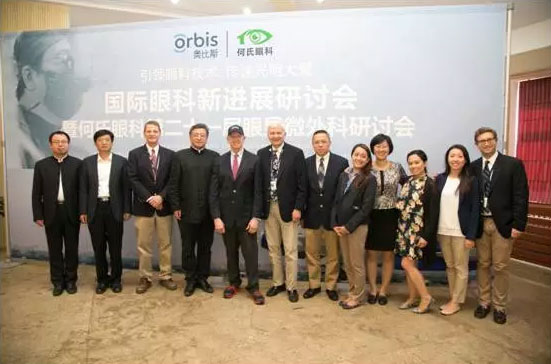
Hassan, a graduate student from Somalia who is now studying at China Medical University, said that as an ophthalmology graduate student who has just been admitted this year, he studied with international experts and expers from He Vision Group over the past two days. He gained much knowledge in cataract, glaucoma and other ophthalmology diseases.
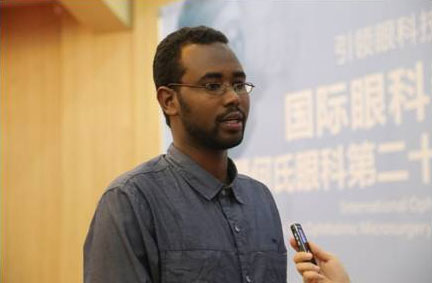
Somali student Hassan is being interviewed by reporters.
Song Shimin, a student from Changchun Yinuo Eye Hospital in Jilin Province, said that as a clinician, he has learned more cutting-edge ophthalmic techniques and knowledge by participating in the seminar, and has broadened his horizons. It provides development directions for future work.
Since the launch of the "Ophthalmology Air Hospital Project" held by the Orbis International and He Vision Group on September 5, a series of international high-end academic exchange and training projects have been held, which have brought subversive technology to the ophthalmology field in Liaoning and even the whole country. It has set up an academic exchange platform for medical workers all over the country.
Dr. James Lehmann, a corneal disease expert at Orbis International Ophthalmic Air Hospital, said that He Vision Group's technology and services have demonstrated the professionalism of Chinese doctors, and their professionalism is even far beyond his imagination. He also hopes to promote the development of corneal transplantation in China through in-depth exchanges and cooperation with He Vision Group.
At the meeting, in addition to a lot of professional knowledge gained by ophthalmologists as students, reporters also learned about many new technologies bring lotsof benefits to ordinary patients.
Innovative Technology 1.
Cataract surgery: discharged 1 hour after operation.
Full femtosecond cataract, more precise and safer.
There are about 8 million blind people in China, and cataract-caused blindness account for 40 per cent of the total. The number cataract patient is still growing at 500,000 a year. At the same time, there are about 28,000 registered ophthalmologists in China, and even fewer are able to perform cataract surgery. The imbalance between doctors and patients and the shortage of professionals are the current situation.
Di Xin, chief expert on cataract in He Eye Specialist Hospital , said: "at present, our most advanced cataract technology in China has kept pace with the international level. For example, the current full femtosecond cataract surgery is more accurate and safer. There are now He Eye instant surgery: with less than 10 minutes of surgery, the patient can be discharged from the hospital after an hour of postoperative observation. But now He Vision Group as a national training center for Prevention and Treatment of Blindness, we need to to make these international high-end technology serve a wider range of patients. Therefore, by working with Orbis International, we hope that more grass-roots ophthalmologists can accept international advanced knowledge and advanced technology. Through training, advanced technology can be quickly carried out in the country. "
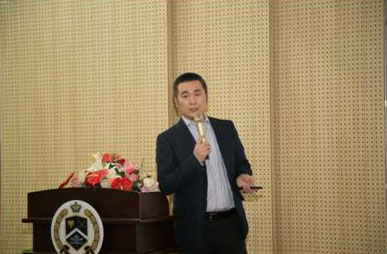
Di Xin, chief specialist of cataract in He Eye Specialist Hospital .
Douglas Fredrick, vice president of the Medical Center of Lucile Packard Children's Hospital at Stanford University in the United States, said congenital cataracts accounted for a certain proportion of cataract patients. In China, the prevalence rate of congenital cataracts is 1/10,000. The number of newborns in China is about 16 million each year, which means that about 1,600 newborns have congenital cataracts. If more doctors can master the treatment of congenital cataracts, they can help more children with congenital cataracts restore their eyesight.
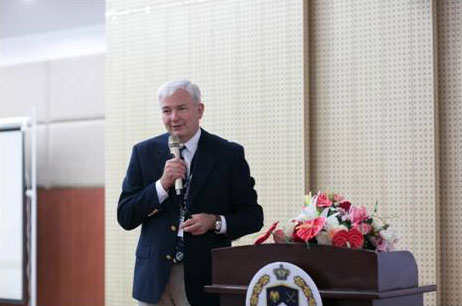
Douglas Fredrick, Vice President, Medical Center, Lucile Packard Children's Hospital, Stanford University, USA.
Innovative Technology 2.
Telemedicine, big data technology.
Minimize blindness and death of patients with diabetes.
There are 100 million diabetics in China and one in every 10 people in Liaoning, but 50% of diabetics have never had an eye health check, and they are not clear that diabetic ophthalmopathy can cause blindness.
In the face of the severe situation of prevention and control of diabetic retinopathy disease, An Liangbao, chief expert on vitreoretinal and ocular trauma in He Eye Specialist Hospital , believes that the uneven distribution of ophthalmic medical resources and the lack of active prevention and control awareness of most patients are important reasons behind this phenomenon. An said: "at present, through telemedicine technology, He Vision Group has set up a remote platform in Liaoning Province, cities, counties, and townships, using big data technology to set up patient files, and setting up 52 diabetic ophthalmopathy screening centers in the whole province. We are building a low-cost, massive, replicable and sustainable city-county-village blindness prevention network. We hope that every diabetic can use this network to check the fundus every six months for early detection and treatment of diabetic ophthalmopathy and minimize blindness and death. "
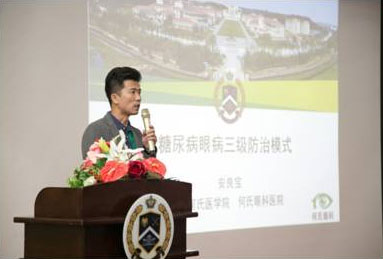
An Liangbao, chief expert on vitreoretinal and ocular trauma in He Eye Specialist Hospital.
Dr. Steven Charles, clinical doctor of ophthalmology at the University of Tennessee and founder of the Charles Retinopathy Center, shared a number of difficult cases, such as how to cut the retina without damaging the retina and reduce the incidence, how to use international standards for vitreous macular surgery and so on. Students benefit a lot.
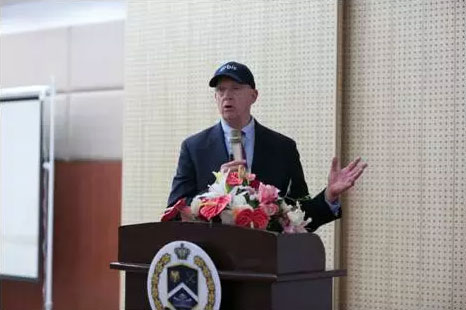
Dr. Steven Charles, Clinical doctor of Ophthalmology at the University of Tennessee and founder of the Charles Retinopathy Center.
Innovative technology 3.
Full femtosecond myopic surgery opens an era of valveless and minimally invasive surgery.
Safer, faster, more precise
Up to now, myopia laser surgery has gone through several stages of development from PRK, LASIK, LASEK, femtosecond laser to full femtosecond. The surgical technology has been upgraded and the safety of operation has been improved. In particular, the advent of full femtosecond technology has brought a revolutionary breakthrough for myopia surgery. Zheng Chunhui, chief expert of laser myopia surgery in He Vision Group, shared the technique at the seminar.
Zheng Chunhui said: full femtosecond technology combines the advantages of femtosecond technology and excimer technology into one, which completely avoids the shortcomings of excimer laser and makes up for the shortcomings of femtosecond technology. It greatly improves the safety, accuracy, predictability and comfort of myopia correction surgery, and the postoperative visual quality is more perfect. Full femtosecond technology has opened the era of "valveless" and "minimally invasive" laser surgery for myopia.
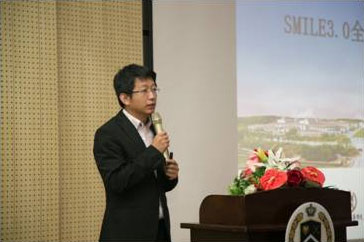
Zheng Chunhui, chief expert of laser myopia surgery in He Vision Group
Categories
Archives
- Mistake "’vague vision" as myopia, saving a 5-year-old cataract child
- Keratopathy expert James: He Eye Specialist Hospital’s professionalism is beyond expectation.
- These new technologies make eye feast - "International Symposium on New Progress in Ophthalmology" was held in Shenyang
- Myopia is a disease. International ophthalmologists’ Suggestions for You.
- Orbis International - He Vision Group Air Hospital Project’s First Recovered Cataract Patient.
